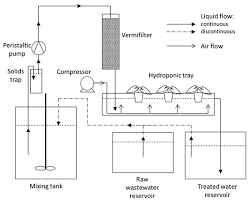EPA Method 3815
Intensive swine farming causes strong local environmental impacts by generating effluents rich in solids, organic matter, nitrogen, phosphorus, and pathogenic bacteria. Insufficient treatment of hog farm effluents has been reported for common technologies, and vermifiltration is considered a promising treatment alternative that, however, requires additional processes to remove nitrate and phosphorus. This work aimed to study the use of vermifiltration with a downstream hydroponic culture to treat hog farm effluents. A treatment system comprising a vermifilter and a downstream deep-water culture hydroponic unit was built.
The treated effluent was reused to dilute raw wastewater. Electrical conductivity, pH, and changes in BOD5, ammonia, nitrite, nitrate, phosphorus, and coliform bacteria were assessed. Plants were monitored throughout the experiment. Electrical conductivity increased due to vermifiltration; pH stayed within a neutral to mild alkaline range. Vermifiltration removed 83% of BOD5, 99% of ammonia and nitrite, and increased nitrate by 11%.
Hydroponic treatment removed BOD5 (63%), ammonia (100%), nitrite (66%), nitrate (27%), and phosphorus (47% total and 44% dissolved) from vermifiltered water. Coliforms were reduced by vermifiltration but recovered in the hydroponic unit. Plants showed the ability to grow on vermifiltered wastewater, although requiring nutrient supplementation. Vermifiltration combined with hydroponics is a promising treatment for swine wastewater, although optimization will be needed for a sustainable real-scale implementation.

There are no products listed under this category.